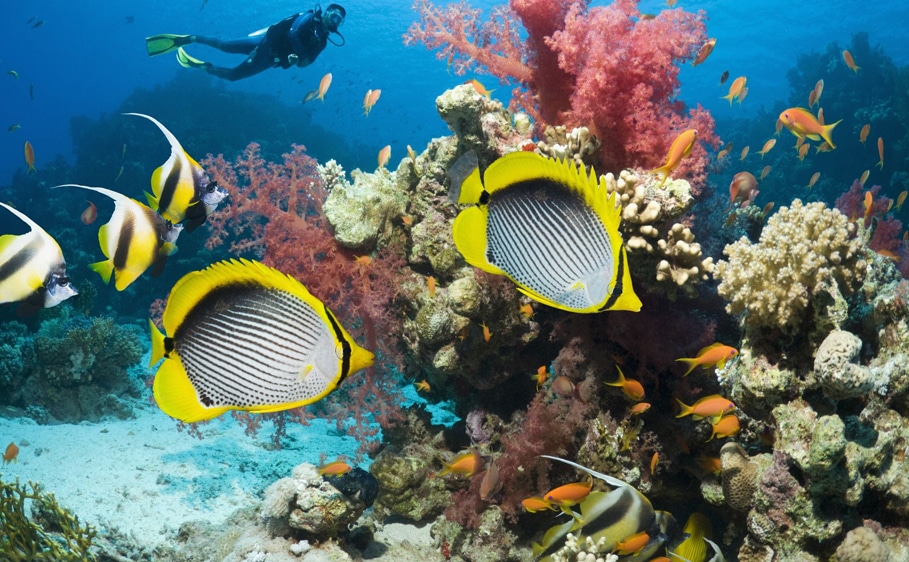
The Geological characteristics of the Red Sea
The Red Sea is a long, narrow marine basin, with a total length of about 1900- km it extends northwards from the strait of Baab El Mandab in Yemen to the southern tip of the Sinai Peninsula in Egypt. Its maximum width is 306 km. The Red Sea has three distinct zones of depth; the shallow reef- studded shelves of less than 50m, the deep shelves of 500- 1000 m. and the central trench of more than 1000 m. The maximum depth of the Red Sea is 3040 m. off Port Sudan. The Red Sea is unique in the several aspects; among them is its uniform temperature distribution at the surface and at the different depths. At the surface near Port Sudan the temperature range is 26.2-30. 5 degrees Celsius; at a depth of 150 m. the range is still 23. 9-25. 0 degrees. Moreover, its high degree of transparency reaches up to 46 m. These characteristics have made the Red Sea an ideal place for snorkels, divers and photographers; it is comfortably warm, one could float nicely and the visibility is better than in most other places. The Sudanese coast is 650 km long as the crow flies; numerous embayments and gulfs make it 750 km long. It has two prominent features; coastal lagoons, locally called marsas, and reefs, called shia”ab in Arabic.
The marsas may be protected embayment of the sea, or may be cut into the coastal plain, well beyond the general coastline. In marsas, despite the heavy fresh water influx during the short rainy season, corals grow and build coral knobs (tens of centimeters to meters in size) and the patch reefs (meters to tens of meters in size). As for the reefs, they are distinguished according to their shapes and positioning. There are the fringing reefs, which are immediately at the cost. They line the entire Sudanese coast, with the exception of the marsas and the Tokar Delta in the south. The fringing reefs are usually 1000 m wide and could extend up to 3000 m. Then there are the barrier reefs, which are generally separated from the coast and the fringing reefs by a ship channel. The barriers range from narrow discontinuous reef walls, only several tens to a few hundred meters wide, to platforms of up to 14- km in width. Finally there are the atolls, which are reef platforms located furthest offshore, several hundreds of meters to a few kilometers in width and surrounded by waters. Examples of these are the Senganeeb Island and Shia ‘ab Rumi. All these types of reef provide shelter to a diversity of marine life. They also offer protected areas for snorkels and shallow-water divers.
Coral reefs
One of the most magnificent features of the Red Sea, are its beautiful coral reefs. Corals, or more precisely, their skeletons, are the main components of which reefs are built. Coral is an animal, individually called a polyp, which is generally one to a few millimeters in diameter. It looks like a bag with six arms (or multiples of six), for its protections and support, it forms a skeleton of a kind of limestone, or correlates, as they are called, are cub or tube shaped. Usually, they live in coral colonies, which may be centimeters to several meters in size. Different kinds of corals occur in different areas of the reef, factors such as waves and light determine the nature of the coral, whether of delicate or solid structure. Thus, the distribution of coral reflects their respective adaptation to the prevailing environment conditions in various parts of the reef. Aside from corals, other elements are also instrumental in the structure of reefs, for example, worms and calcareous red algae, a form of marine plants.
Marine life
Surrounding the reefs and complimenting them in creating a breath- taking sight, is the wide spectrum of marine life. The Red Sea is famous for its plants and animals; many of which are related to those of the Indian Ocean, but some of which are exclusively found in the Red Sea. Among the common fish in the Red Sea are the Tarpon, Giant Herring, Salmon Herring or milkfish, Soldier fish, Goggle Eye and Rock Cod. There are also more than 320 species of sharks, among them such veracious predators as the Tiger Shark and Hammer Shark. It should be noted, however, that unless irritated or attracted by blood, sharks are peaceful animals and, generally speaking shark attacks along the Red Sea coast are very rare. In addition, several species of whales also find home in the Red Sea, namely the Blue Whale, a 15 m-long giant which feeds on plankton, and the killer Whale, which poses no threat to humans, but scares off sharks. The Whale Shark, 8 to 10m in length, is a jolly, plankton- eating whale that befriends fishermen.
Recreational Activities
All these characteristics and many they make the Red Sea an attractive location for vacations and relaxation. This is especially true for those who love the Sea and enjoy its offerings. Fans of scuba diving, snorkeling, yachting and various water sports will find the necessary conditions on the Sudanese Red Sea to pursue these activities to their ultimate satisfaction.